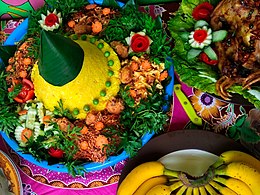
Back ساتاي Arabic Sate Azerbaijani Satay BCL Sété BJN Satai Catalan Saté Czech Saté German Σατέ Greek Sateo Esperanto Satay Spanish
 Sate Ponorogo, grilled marinated chicken satay served in peanut sauce, a speciality of Ponorogo, a town in East Java, Indonesia | |
| Alternative names | Sate, Satai, Satti |
|---|---|
| Course | Entrée or main course |
| Place of origin | Indonesia[1][2][3] |
| Region or state | Java[2] |
| Associated cuisine | Indonesia,[1] Malaysia,[4][5] Filipino,[6] Singapore,[7][8] and Thailand[9] |
| Serving temperature | Hot |
| Main ingredients | Skewered and grilled meats with various sauces, mainly peanut sauce |
| Variations | Numerous variations across Southeast Asia |
 |
| This article is part of the series on |
| Indonesian cuisine Masakan Indonesia |
|---|
|
|
Satay (/ˈsɑːteɪ/ SAH-tay, in the US also /ˈsæteɪ/ SA-tay), or sate in Indonesia, is a Javanese dish of seasoned, skewered and grilled meat, served with a sauce. Satay originated in Java,[2][3][10][11][12] but has spread throughout Indonesia, into Southeast Asia, Europe, America, and beyond.
Indonesian satay is often served with peanut sauce and kecap manis – a sweet soy sauce, and is often accompanied with ketupat or lontong, a type of rice cake, though the diversity of the country has produced a wide variety of satay recipes. It is also popular in many other Southeast Asian countries including Brunei, Malaysia, Philippines, Singapore and Thailand.[13][14] It also recognized and popular in Suriname and the Netherlands.[15] [16] In Sri Lanka, it has become a staple of the local diet as a result of the influences from the local Malay community.[17]
Satay may consist of diced or sliced chicken, goat, mutton, beef, pork, fish, other meats, or tofu; bamboo skewers are often used, while rustic style of preparations employ skewers from the midrib of the coconut palm frond. The meat is grilled over a wood or charcoal fire, then served with various spicy seasonings. Satay can be served in various sauces; however, most often they are served in a combination of soy and peanut sauce,[18] causing the sauce alone to often be referred to as "satay".[19]
The national dish of Indonesia,[1][20][21][22] satay is popular as street food,[2] found in restaurants, and at traditional celebration feasts. Close analogues are yakitori from Japan, kǎoròu chuàn from China, seekh kebab from India, shish kebab from Turkey and the Middle East, shashlik from the Caucasus, and sosatie from South Africa. It is listed at number 14 on World's 50 most delicious foods readers' poll compiled by CNN Go in 2011.[23]
- ^ a b c Sara Schonhardt (25 February 2016). "40 Indonesian foods we can't live without". CNN International. Hong Kong: Warner Bros. Discovery. Archived from the original on 6 April 2017. Retrieved 13 April 2017.
- ^ a b c d Bruce Kraig; Colleen Taylor Sen Ph.D. (9 September 2013). Street Food around the World: An Encyclopedia of Food and Culture: An Encyclopedia of Food and Culture. ABC-CLIO. p. 183. ISBN 978-1-59884-955-4.
- ^ a b O'Neill, Molly (2 July 2000). "Food; The Stick Shift". The New York Times. ISSN 0362-4331. Archived from the original on 3 July 2020. Retrieved 13 April 2020.
- ^ Michael Specter (2 December 1984). "IN MALAYSIA, SPICY SATAY". The New York Times. Archived from the original on 26 December 2018. Retrieved 27 August 2020.
- ^ Shalini Ravindran (28 June 2018). "Five places for great satay". The Star. Archived from the original on 8 October 2020. Retrieved 27 August 2020.
- ^ "Satti: A spicy delicacy for breakfast". 2 September 2019.
- ^ "So much more to satay than peanut sauce". Food. Archived from the original on 21 August 2018. Retrieved 21 August 2018.
- ^ Eliot, Joshua (1994). Indonesia, Malaysia & Singapore Handbook. New York: Trade & Travel Publications. p. 352.
- ^ Erickson, Joan (1982). Southeast Asia Sunset travel guides. Lane Publishing Company. p. 78. ISBN 978-037-606-764-7.
- ^ "Consumers love succulent Satay, Peanut ingredients for global success" (PDF). USA Peanuts. p. 1. Archived from the original (PDF) on 2 May 2014. Retrieved 2 May 2014.
- ^ Felicity Cloake (30 January 2014). "How to cook the perfect chicken satay". The Guardian. Archived from the original on 14 July 2014. Retrieved 7 July 2014.
- ^ "Satay Washington DC". satay.com. Archived from the original on 9 January 2019. Retrieved 6 July 2014.
- ^ "Grilled Beef Satay". Food Reference.com. Archived from the original on 15 August 2010. Retrieved 6 July 2010.
- ^ Alan, Davidson (2006). The Oxford Companion to Food (2nd ed.). Oxford: OUP. ISBN 9780191018251. OCLC 862049879.
- ^ admin (11 December 2013). "What is Satay Food and Its Origin". Satay Ria. Archived from the original on 7 June 2020. Retrieved 7 June 2020.
- ^ "So much more to satay than peanut sauce". Food. Archived from the original on 21 August 2018. Retrieved 21 August 2018.
- ^ Bullis, Douglas; Hutton, Wendy (2001). Food of Sri Lanka. Periplus. p. 14.
- ^ Marx, Pamela (1996). The Travel-the-world Cookbook. Good Year Books. p. 30. ISBN 9780673362544.
indonesian satay peanut sauce.
- ^ "Peanut butter and satay sauce – recipe". The Guardian. Archived from the original on 8 February 2017. Retrieved 7 February 2017.
- ^ Media, Kompas Cyber. "Kemenpar Tetapkan 5 Makanan Nasional Indonesia, Ini Daftarnya". KOMPAS.com (in Indonesian). Archived from the original on 18 April 2018. Retrieved 18 April 2018.
- ^ Owen, Sri (1999). Indonesian Regional Food and Cookery. ISBN 9780711212732. Archived from the original on 9 October 2013. Retrieved 7 July 2010.
- ^ Sara Schonhardt and Melanie Wood (15 August 2011). "40 of Indonesia's best dishes". CNN. Archived from the original on 26 December 2018. Retrieved 6 July 2014.
- ^ CNN Go [1] Archived 11 November 2012 at the Wayback Machine Your pick: World's 50 most delicious foods, 7 September 2011. Retrieved 11 October 2011